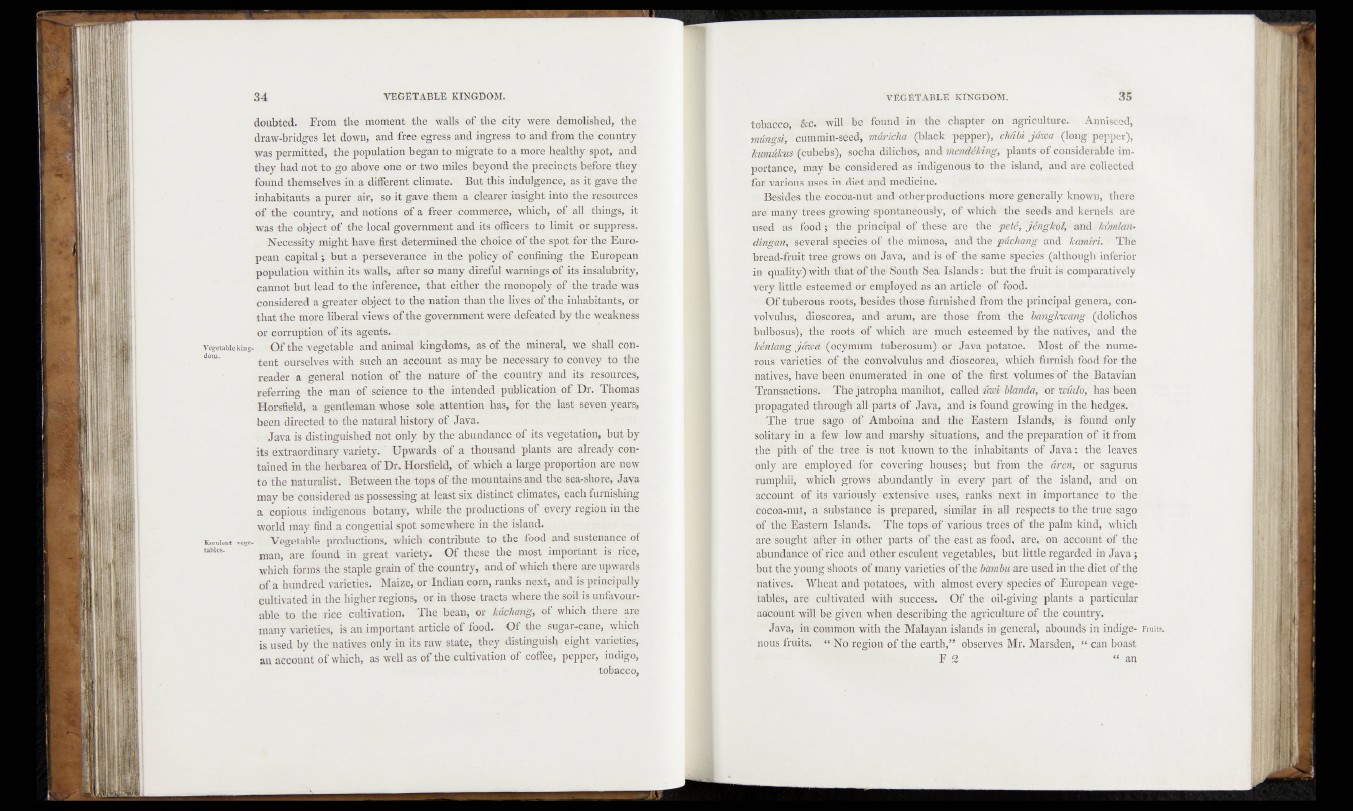
doubted. From the moment the Walls of the city were demolished, the
draw-bridges let down, and free egress and ingress to and from the, country
was permitted, the population began to migrate to a more healthy spot, and
they had not to go above one or two miles beyond the precincts before they
found themselves in a different climate. But this indulgence, as it gave the
inhabitants a purer air, so it gave them a clearer insight into the resources
of the country, and notions of a freer commerce, which* of all things; it
was the object of .the local government and its officers to limit or suppress,
î .Necessity might have first'determined-the .choice of the spot for the European
capital ; but a perseverance in the policy of confining the European
population within its walls, after so many direful warnings of -its insalubrity,
cannot hut lead to «the inference, that either the monopoly of the trade was
considered a greater object to the nation than the dives of the inhabitants, or
that the more liberal views of the government were defeated by the weakness
or corruption of its agents.
Vegetable king«--Of the vegetable and animal kingdoms, as of the mineral, we shall content
ourselves with sueh an account as may be necessary to-convey to the
leader a general notion of the nature of the country and -its resources,
referring the man of science to the intended publication of JDr. Thomas
Horsfield, a gentleman whose sole attention has, for-the làst seven years,
been directed to the natiiralhistory of Java.
i Java is distinguished not only by the abundance of its vegetation, but by
its extraordinary variety. * ’Upwards of a thousand plants are. îdçeady contained
in the herbarea of Dr. Horsfield, of which a large proportion are new
to the naturalist. Betwèen the tops of the mountains and the, sea-shore, Java
may be considered as possessing at least six distinct climates, each;fu?iSshing
a copious indigenous botany, while the production of jeyeiy regiQntin.thc
world may find a .congenial spot somewhere in the island.
Esculent vege- Vegetable productions, which contribute Jo the food and sustenance of
tables- man, are found in great variety. Of these the most important is. rice,
which forins the staple grain of the: coumtiy, and of which there are upwards
of a hundred' varieties. Maize, pr Indian corn, ranks next, and. is principally
cultivated in the higher regions,, or in those tracts where the soil is Unfavoui-r
able to the. rice cultivation. The. bean, or kqc/iang, of which there are
many varieties, is an important article of food. Of -the sugar-cane, which
is Used by the natives only in its raw state, they distinguish eight varieties,
an account of which, as well as of the . cultivation of coffee, pepper, indigo,
tobacco,
toba‘cco>' &c.” wil'1 'be''found in the chapter on agriculture. AnnistefecP,
mungsi,* cummin-seed1, markka • (black pepper), cMbi jêma (long pepper),
Mmi'clcus (cubebs), socha dilichos, and meredehing, plants of considerable importance,
may be considered as indigenous to the island, and arU collected
for various .uSea irL diet and medicine.8
Besides thti eocosa-nuejautb otherproductions more generally known, there
are many trées growing- spontaneously, of which’ the seeds and kernels are
used -as foöd"; itlfe principal of these' aro the p6t&, and kÓMlan*
dÈtgqüi1Sel^SkspMciis of- the' mimosa, and the' ^übh’ang and! Jcamiriï; The
bread-fruit treë g'rbws on Java, and is of the-Same spheies (although inferibf
in quality)'With th at of the! South1 Sea^Islaridfer: btit the fruit is* comparatively
very little estefemed on eipployedTas an article of food'. •
Oft’obéïöus roots, -besidOS tiiose furnished ftóm the principal genera, convolvulus,
di'Qseoïèa, and arum,' are those from the bahgfcwéng' (dolichos
bulbosu’s)'/ the roots.' of which are much esteemed- by the natives, arid* the
kêntang jcbweè (ocymUtn .tuberosum).' or 'Java- pbtatoe. ‘Most of Ae^rrume-
rolls' varieties of the' convolvulus'and' dioscorea', which furnish'foad■ for the
natives, have' b’éêib enumerated' in one of the 'first1 volumes'of the Batavian
Transactions; The jatfopha' manihot,’' bailed uxnt bkmdd, or wüdbi has been
propagated« through all parts of Java, and is found growing in the hedges.
' Thö; true sagö> of Ambóina and tiie Eastern Islands/ is found only
solitary in a few low and marshy situations, and the preparation of it from
the’ pith «ëf! the' tree-is-not known tothéVinhabitants'of Java;'the leaves
only are empléyed'Jar. covering houses; • htit from the dren,’ or sagurus
rumphii, which grows abundantly in every part of the island, and on
account of its variously extensive uses;1'ranks next in importance to the
cOcoa-nUit, a substance is prepared, similar ite- all respects to the'true sago
of the Eastern Islands; The tops oif Various trdös óf the palm kind, which
are'soöght after in’other parts of the .east as’food,-are, ’on account of the
abundance of rice arid other esculent vegetables; btit little regarded in Java;
but the young shoots of many varieties of the bambu are used in the diet of thp
natives.- Wheat and potatoes, With‘ almost every speeresof European vegetables,
are cultivated with success. Of the oil-giving plants a particular
aoteount will be given when describing the agriculture of the country.
Java, in common with the Malayan islands in general; abounds in indige- Fr
nous fruits. " No^region of the earth,'” observes Mr. Marsden, “ can boast
F g “ an